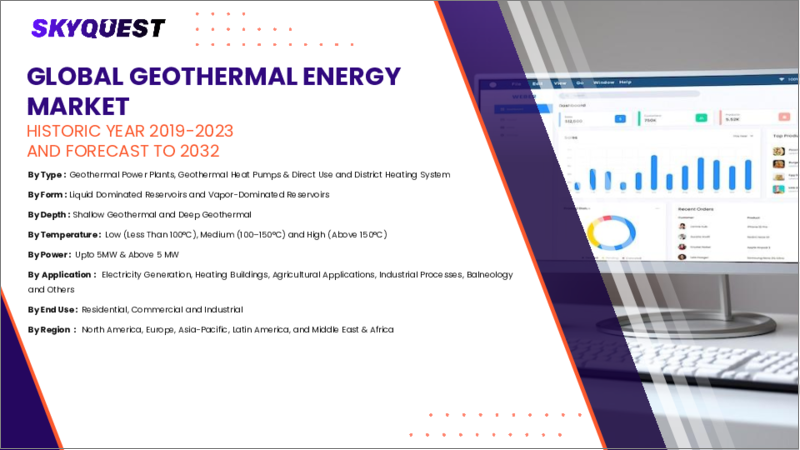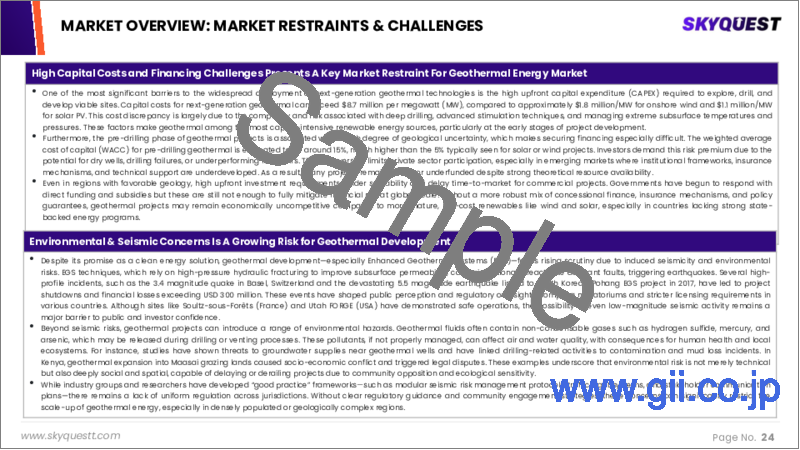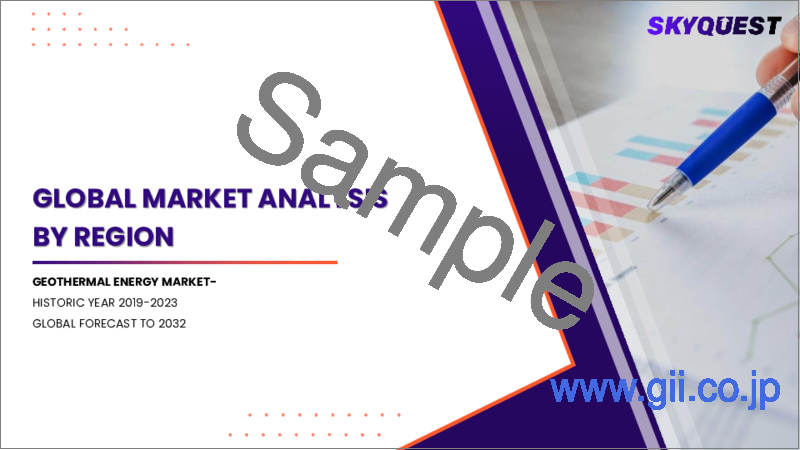|
|
市場調査レポート
商品コード
1743336
地熱エネルギー市場規模、シェア、成長分析、技術別、電力別、温度別、用途別、地域別-2025年~2032年産業予測Geothermal Energy Market Size, Share, and Growth Analysis, By Technology (Binary Cycle Plants, Flash Steam Plants), By Power (Up to 5MW, Above 5 MW), By Temperature, By Application, By Region - Industry Forecast 2025-2032 |
||||||
|
|||||||
| 地熱エネルギー市場規模、シェア、成長分析、技術別、電力別、温度別、用途別、地域別-2025年~2032年産業予測 |
|
出版日: 2025年06月02日
発行: SkyQuest
ページ情報: 英文 198 Pages
納期: 3~5営業日
|
全表示
- 概要
- 目次
地熱エネルギーの世界市場規模は2023年に74億5,000万米ドルと評価され、2024年の76億8,000万米ドルから2032年には98億1,000万米ドルに成長し、予測期間(2025年~2032年)のCAGRは3.1%で成長する見通しです。
世界の地熱エネルギー部門は、持続可能なエネルギー源への移行に伴い、住宅、商業、産業部門にわたる信頼性の高い電力供給に対する需要の高まりによって力強い成長を遂げています。この転換は、化石燃料への依存を減らし、温室効果ガスの排出を抑制するために極めて重要であり、各国がエネルギー戦略に地熱エネルギーを取り入れるよう促しています。特に中東のような新興市場では、各国が野心的な生産能力目標を掲げており、戦略的パートナーシップと地域イニシアティブは、競合情勢を再定義する上で不可欠です。民間セクター間のコラボレーションは、地熱エネルギープロジェクトに対する信頼の高まりを浮き彫りにし、エネルギーの持続可能性の達成と環境パフォーマンスの向上における地熱エネルギーの役割をさらに強調しています。全体として、この分野は投資と技術革新のための有望な手段です。
目次
イントロダクション
- 調査の目的
- 調査範囲
- 定義
調査手法
- 情報調達
- 二次と一次データの方法
- 市場規模予測
- 市場の前提条件と制限
エグゼクティブサマリー
- 世界市場の見通し
- 供給と需要の動向分析
- セグメント別機会分析
市場力学と見通し
- 市場概要
- 市場規模
- 市場力学
- 促進要因と機会
- 抑制要因と課題
- ポーターの分析
主な市場の考察
- 重要成功要因
- 競合の程度
- 主な投資機会
- 市場エコシステム
- 市場の魅力指数(2024年)
- PESTEL分析
- マクロ経済指標
- バリューチェーン分析
- 価格分析
地熱エネルギー市場規模:技術別& CAGR(2025年~2032年)
- 市場概要
- バイナリサイクルプラント
- フラッシュスチームプラント
- 乾き蒸気プラント
- 地中熱ヒートポンプ
- ダイレクトシステムズ
- その他
地熱エネルギー市場規模:電力別& CAGR(2025年~2032年)
- 市場概要
- 最大5MW
- 5MW以上
地熱エネルギー市場規模:温度別& CAGR(2025年~2032年)
- 市場概要
- 低温(最大900℃)
- 中温(900℃~1500℃)
- 高温(1500℃以上)
地熱エネルギー市場規模:用途別& CAGR(2025年~2032年)
- 市場概要
- 発電
- 住宅暖房・冷房
- 商業用暖房・冷房
地熱エネルギー市場規模& CAGR(2025年~2032年)
- 北米
- 米国
- カナダ
- 欧州
- ドイツ
- スペイン
- フランス
- 英国
- イタリア
- その他の欧州
- アジア太平洋
- 中国
- インド
- 日本
- 韓国
- その他のアジア太平洋
- ラテンアメリカ
- ブラジル
- その他のラテンアメリカ
- 中東・アフリカ
- GCC諸国
- 南アフリカ
- その他の中東・アフリカ
競合情報
- 上位5社の比較
- 主要企業の市場ポジショニング(2024年)
- 主な市場企業が採用した戦略
- 最近の市場動向
- 企業の市場シェア分析(2024年)
- 主要企業の企業プロファイル
- 企業の詳細
- 製品ポートフォリオ分析
- 企業のセグメント別シェア分析
- 収益の前年比比較(2022年~2024年)
主要企業プロファイル
- Ormat Technologies, Inc.(USA)
- Mitsubishi Heavy Industries, Ltd.(Japan)
- Calpine Corporation(USA)
- Enel Green Power S.p.A.(Italy)
- Energy Development Corporation(Philippines)
- Toshiba Energy Systems & Solutions Corporation(Japan)
- Fuji Electric Co., Ltd.(Japan)
- Berkshire Hathaway Energy Renewables(USA)
- Chevron Corporation(USA)
- Star Energy Geothermal(Indonesia)
- Pertamina Geothermal Energy(PGE)(Indonesia)
- Aboitiz Power Corporation(Philippines)
- Baker Hughes Company(USA)
- Exergy International Srl(Italy)
- Atlas Copco Group(Sweden)
- TAS Energy(USA)
- Turboden S.p.A.(Italy)
- Cyrq Energy(USA)
- Controlled Thermal Resources(USA)
- Fervo Energy(USA)
結論と提言
Global Geothermal Energy Market size was valued at USD 7.45 Billion in 2023 and is poised to grow from USD 7.68 Billion in 2024 to USD 9.81 Billion by 2032, growing at a CAGR of 3.1% in the forecast period (2025-2032).
The global geothermal energy sector is experiencing robust growth driven by the rising demand for reliable power supply across residential, commercial, and industrial sectors, in tandem with the shift towards sustainable energy sources. This transition is pivotal for reducing reliance on fossil fuels and curbing greenhouse gas emissions, prompting countries to incorporate geothermal energy into their energy strategies. Strategic partnerships and regional initiatives are vital in redefining the competitive landscape, especially in emerging markets such as the Middle East, where nations are setting ambitious capacity goals. Collaborations between private sector players highlight growing confidence in geothermal energy projects, further emphasizing its role in achieving energy sustainability and enhancing environmental performance. Overall, the sector represents a promising avenue for investment and innovation.
Top-down and bottom-up approaches were used to estimate and validate the size of the Global Geothermal Energy market and to estimate the size of various other dependent submarkets. The research methodology used to estimate the market size includes the following details: The key players in the market were identified through secondary research, and their market shares in the respective regions were determined through primary and secondary research. This entire procedure includes the study of the annual and financial reports of the top market players and extensive interviews for key insights from industry leaders such as CEOs, VPs, directors, and marketing executives. All percentage shares split, and breakdowns were determined using secondary sources and verified through Primary sources. All possible parameters that affect the markets covered in this research study have been accounted for, viewed in extensive detail, verified through primary research, and analyzed to get the final quantitative and qualitative data.
Global Geothermal Energy Market Segments Analysis
Global Geothermal Energy Market is segmented by Technology, Power, Temperature, Application and region. Based on Technology, the market is segmented into Binary Cycle Plants, Flash Steam Plants, Dry Steam Plants, Ground Source Heat Pumps, Direct Systems and Others. Based on Power, the market is segmented into Up to 5MW and Above 5 MW. Based on Temperature, the market is segmented into Low Temperature (Up to 900C), Medium Temperature (900C - 1500C) and High Temperature (Above 1500C). Based on Application, the market is segmented into Power Generation, Residential Heating and Cooling and Commercial Heating and Cooling. Based on region, the market is segmented into North America, Europe, Asia Pacific, Latin America and Middle East & Africa.
Driver of the Global Geothermal Energy Market
The Global Geothermal Energy market is propelled by the urgent need for reliable and consistent power sources in the shift towards a decarbonized energy landscape. Geothermal energy stands out as it can deliver stable baseload power continuously, unlike the intermittent nature of solar and wind sources. This reliability makes geothermal a vital element in achieving a sustainable energy framework. Countries such as the United States, Iceland, and Indonesia are actively expanding their geothermal capabilities to lessen dependency on fossil fuels. A notable advancement occurred in 2024 when Fervo Energy successfully showcased enhanced geothermal systems (EGS) through innovative AI-driven subsurface modeling, enhancing energy extraction efficiency.
Restraints in the Global Geothermal Energy Market
The Global Geothermal Energy market faces significant challenges primarily stemming from its substantial financial demands, which encompass drilling and plant installation costs. For instance, establishing a geothermal plant with a one-megawatt capacity can range between USD 2 million and USD 7 million. In contrast, competing renewable energy options like onshore and offshore wind power, as well as solar photovoltaics, exhibit lower overall expenses due to reduced production costs. As a result, from a long-term viewpoint, these more economically viable renewable sources are likely to hinder the growth and market share of geothermal energy, making it less attractive to investors.
Market Trends of the Global Geothermal Energy Market
The Global Geothermal Energy market is witnessing a significant trend towards the advancement of Enhanced Geothermal Systems (EGS), which broadens the scope of geothermal energy harnessing beyond traditional hot water reservoirs. The successful commercial testing of EGS technologies, such as Fervo Energy's recent achievement in Nevada, highlights the potential to create artificial reservoirs in previously unutilized regions. By utilizing innovations like fiber-optic sensing and AI-driven optimization, EGS is set to unlock new geothermal sites, driving a substantial increase in geothermal power generation. This evolution not only enhances energy diversification but also supports global sustainability goals, positioning geothermal energy as a key player in the renewable energy sector.
Table of Contents
Introduction
- Objectives of the Study
- Scope of the Report
- Definitions
Research Methodology
- Information Procurement
- Secondary & Primary Data Methods
- Market Size Estimation
- Market Assumptions & Limitations
Executive Summary
- Global Market Outlook
- Supply & Demand Trend Analysis
- Segmental Opportunity Analysis
Market Dynamics & Outlook
- Market Overview
- Market Size
- Market Dynamics
- Drivers & Opportunities
- Restraints & Challenges
- Porters Analysis
- Competitive rivalry
- Threat of substitute
- Bargaining power of buyers
- Threat of new entrants
- Bargaining power of suppliers
Key Market Insights
- Key Success Factors
- Degree of Competition
- Top Investment Pockets
- Market Ecosystem
- Market Attractiveness Index, 2024
- PESTEL Analysis
- Macro-Economic Indicators
- Value Chain Analysis
- Pricing Analysis
Global Geothermal Energy Market Size by Technology & CAGR (2025-2032)
- Market Overview
- Binary Cycle Plants
- Flash Steam Plants
- Dry Steam Plants
- Ground Source Heat Pumps
- Direct Systems
- Others
Global Geothermal Energy Market Size by Power & CAGR (2025-2032)
- Market Overview
- Up to 5MW
- Above 5 MW
Global Geothermal Energy Market Size by Temperature & CAGR (2025-2032)
- Market Overview
- Low Temperature (Up to 900C)
- Medium Temperature (900C - 1500C)
- High Temperature (Above 1500C)
Global Geothermal Energy Market Size by Application & CAGR (2025-2032)
- Market Overview
- Power Generation
- Residential Heating and Cooling
- Commercial Heating and Cooling
Global Geothermal Energy Market Size & CAGR (2025-2032)
- North America (Technology, Power, Temperature, Application)
- US
- Canada
- Europe (Technology, Power, Temperature, Application)
- Germany
- Spain
- France
- UK
- Italy
- Rest of Europe
- Asia Pacific (Technology, Power, Temperature, Application)
- China
- India
- Japan
- South Korea
- Rest of Asia-Pacific
- Latin America (Technology, Power, Temperature, Application)
- Brazil
- Rest of Latin America
- Middle East & Africa (Technology, Power, Temperature, Application)
- GCC Countries
- South Africa
- Rest of Middle East & Africa
Competitive Intelligence
- Top 5 Player Comparison
- Market Positioning of Key Players, 2024
- Strategies Adopted by Key Market Players
- Recent Developments in the Market
- Company Market Share Analysis, 2024
- Company Profiles of All Key Players
- Company Details
- Product Portfolio Analysis
- Company's Segmental Share Analysis
- Revenue Y-O-Y Comparison (2022-2024)
Key Company Profiles
- Ormat Technologies, Inc. (USA)
- Company Overview
- Business Segment Overview
- Financial Updates
- Key Developments
- Mitsubishi Heavy Industries, Ltd. (Japan)
- Company Overview
- Business Segment Overview
- Financial Updates
- Key Developments
- Calpine Corporation (USA)
- Company Overview
- Business Segment Overview
- Financial Updates
- Key Developments
- Enel Green Power S.p.A. (Italy)
- Company Overview
- Business Segment Overview
- Financial Updates
- Key Developments
- Energy Development Corporation (Philippines)
- Company Overview
- Business Segment Overview
- Financial Updates
- Key Developments
- Toshiba Energy Systems & Solutions Corporation (Japan)
- Company Overview
- Business Segment Overview
- Financial Updates
- Key Developments
- Fuji Electric Co., Ltd. (Japan)
- Company Overview
- Business Segment Overview
- Financial Updates
- Key Developments
- Berkshire Hathaway Energy Renewables (USA)
- Company Overview
- Business Segment Overview
- Financial Updates
- Key Developments
- Chevron Corporation (USA)
- Company Overview
- Business Segment Overview
- Financial Updates
- Key Developments
- Star Energy Geothermal (Indonesia)
- Company Overview
- Business Segment Overview
- Financial Updates
- Key Developments
- Pertamina Geothermal Energy (PGE) (Indonesia)
- Company Overview
- Business Segment Overview
- Financial Updates
- Key Developments
- Aboitiz Power Corporation (Philippines)
- Company Overview
- Business Segment Overview
- Financial Updates
- Key Developments
- Baker Hughes Company (USA)
- Company Overview
- Business Segment Overview
- Financial Updates
- Key Developments
- Exergy International Srl (Italy)
- Company Overview
- Business Segment Overview
- Financial Updates
- Key Developments
- Atlas Copco Group (Sweden)
- Company Overview
- Business Segment Overview
- Financial Updates
- Key Developments
- TAS Energy (USA)
- Company Overview
- Business Segment Overview
- Financial Updates
- Key Developments
- Turboden S.p.A. (Italy)
- Company Overview
- Business Segment Overview
- Financial Updates
- Key Developments
- Cyrq Energy (USA)
- Company Overview
- Business Segment Overview
- Financial Updates
- Key Developments
- Controlled Thermal Resources (USA)
- Company Overview
- Business Segment Overview
- Financial Updates
- Key Developments
- Fervo Energy (USA)
- Company Overview
- Business Segment Overview
- Financial Updates
- Key Developments






